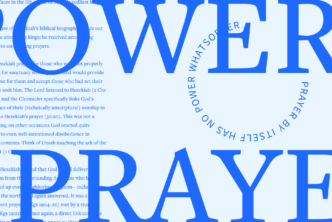Genesis 1:26–27 tells us that as humans, we are made in God’s image. But what does that mean? Ask a few Christians, and you’ll probably get several different responses.
What makes humans unique?
Dr. Michael Heiser, Bible scholar and author of the new book, The Unseen Realm, says that we often base our status as image bearers on one or more of the following qualities:
- Intelligence
- Reasoning ability
- Emotions
- The ability to commune with God
- Self-awareness (sentience)
- Language/communication ability
- The presence of a soul or spirit (or both)
- The conscience
- Free will
At a glance, this might seem like a strong list of qualities we uniquely share with God. We can generally agree that most of these qualities distinguish humans from the other things God created. But Dr. Heiser says, “The image of God means none of those things. If it did, then Bible-believers ought to abandon the idea of the sanctity of human life in the womb. That assertion may jar you, but it’s quite evident once you really consider that list in light of how Scripture talks about the image of God.”
What does it mean to be made in God’s image?
In The Unseen Realm, Dr. Heiser uses the ancient Hebrew worldview of the supernatural to cast a biblical light on our relationship to the divine. To fully grasp that relationship, we have to take another look at what it means to be made in God’s image.’
Referring back to the list above, Heiser says, “The problem with defining the image by any of these qualities is that, on one hand, nonhuman beings like animals possess some of these abilities, although not to the same extent as humans. If one animal anywhere, at any time, learned anything contrary to instinct, or communicated intelligently (to us or within species), or displayed an emotional response (again to us or other creatures), those items must be ruled out as image bearing. We know certain animals have these abilities because of carefully conducted research in the field of animal cognition. Artificial intelligence is on the verge of similar breakthroughs.”
Our list just got a lot shorter. If all human life uniquely bears the image of God, we have to definitively know that no other species bears (or could bear) these qualities. Or, we need to specify the combination that is uniquely human. Putting any qualities on this list is risky—can we afford to stake our identity as God’s image on any one quality? Heiser goes on:
“Defining image bearing as any ability is a flawed approach. This brings me back to my pro-life assertion. The pro-life position is based on the proposition that human life (and so, personhood) begins at conception (the point when the female egg is fertilized by the male sperm). The simple-celled zygote inside the woman’s womb, which pro-lifers believe to be a human person, is not self-aware; it has no intelligence, rational thought processes, or emotions; it cannot speak or communicate; it cannot commune with God or pray; and it cannot exercise its will or respond to the conscience. If you want to argue that those things are there potentially, then that means that you have only a potential person. That’s actually the pro-choice position. Potential personhood is not actual personhood. This thought process would mean that abortion is not killing until personhood is achieved . . .”
So how do we define God’s image (and thereby, “personhood”) to include all humans? Dr. Heiser believes that a proper understanding of Hebrew grammar makes all the difference.
He says, “The turning point is the meaning of the preposition in with respect to the phrase “in the image of God.” In English we use the preposition in to denote many different ideas. . . . For example, if I say, ‘put the dishes in the sink,’ I am using the preposition to denote location. If I say, ‘I broke the mirror in pieces,’ I am using in to denote the result of some action. If I say, ‘I work in education,’ I am using the preposition to denote that I work as a teacher or principal, or in some other educational capacity.”
Did you catch the difference there?
“Humankind was created as God’s image. If we think of imaging as a verb or function, that translation makes sense. We are created to image God, to be his imagers. It is what we are by definition. The image is not an ability we have, but a status. We are God’s representatives on earth. To be human is to image God.”
Being a human doesn’t mean you are an image of God, it means that you are imaging God by being human.
As a noun, an image is a copy, a symbol, or a representation. One dictionary defines it as “a physical likeness or representation of a person, animal, or thing, photographed, painted, sculptured, or otherwise made visible.” When we think of being made in the image of God, this is what often comes to mind—we’re fleshy images of God. God sculpted images of himself out of dust, and made them flesh (Genesis 2:7). Merriam-Webster even references Genesis 1:27 in one of it’s definitions of image: exact likeness or semblance (meaning, “the state of being somewhat like something but not truly or fully the same thing”).
Do you see the problem with using image as a noun here? It implies that there are qualities or traits that set humans apart as images of God—unique qualities which we cannot define without excluding (or potentially excluding) life in the womb. When we look at a statue, we can use a set of qualities or standards to determine what that statue represents (and how accurately it represents it). Is it a human? An animal? A mythological creature? We can even compare that statue to paintings or pictures or similar statues to determine how clearly it portrays what the artist claims it is. But that’s not how being in the image of God works.
The “medium” of God’s image is humanity. If you are human, you are in the image of God, regardless of the qualities you possess.
Heiser suggests that the image of God is a status, and imaging God is something we do by being human. Used as a verb, it means to make an image, to portray, or to project on a surface. In a very real sense, being made in God’s image means you are projecting God on earth—wherever you are, and whatever you look like. Whether you’re in the womb, or reading words on a screen, you are in the image of God.
We are “God projectors” that turn on at conception and never turn off.
Dr. Heiser talks about the image of God in more detail on this episode of Faithlife Today (Heiser starts at 2:13):

* * *
Want to see how Dr. Heiser’s insights on the image of God tie into his study of the supernatural worldview of the Bible? In The Unseen Realm, Heiser uses his mastery of biblical Hebrew and other ancient languages to illuminate God’s spiritual realm, offering insight into how that world interacts with our own.
This scholarly work which began fifteen years ago is available now. Get your copy of The Unseen Realm here.
Photo credit: Christine Szeto.







